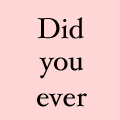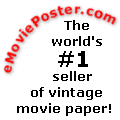 |
Half-sheets measure 22" x 28"
horizontally (approximately half the size of a one
sheet) and were printed on card stock, which made them more versatile
than the paper materials. They were used in special sized lobby displays
inside of theatres.
 Studios
called these pieces 22x28 lobby cards. Collectors named this poster the
half sheet because of it's size. So if you look in a presskit, the poster
will be listed as a 22x28 lobby card. Studios
called these pieces 22x28 lobby cards. Collectors named this poster the
half sheet because of it's size. So if you look in a presskit, the poster
will be listed as a 22x28 lobby card.
The artwork on the half-sheet may or may
not be the same as that of the one-sheet.
Half-sheets were normally sent to the theaters folded into quarters which measured 11x14 and the same as the lobby cards. This made it easier for mailing. In the 1970s, it became popular to send them rolled instead of folded. Half-sheets were
sometimes released in more than one style, such
as Styles "A" and "B." In some cases the studio would issue one style
using photography and one style using painted artwork on the other.
During 1968, NSS
started the change from putting their NSS
numbers in the bottom right border to putting them on the top of the
left and right side borders.
HISTORY
Half-sheets were first introduced by movie
studios in the 1910's, shortly after the release of one-sheet
and lobby cards. They were initially printed using
a brown-and-white rotogravure process. In
the 1920's, studios began producing their card stock materials through a
process known as photogelatin/collotype or heliotype. Because this process
utilized duller dyes than did lithography,
the colors of the half sheets look better close up than they do when
viewed from a distance.
Half sheets were a main tool in the advertising
arsenal until the mid 1980's. Prior to this time, most theatres had just one
screen and one feature movie. A lot more advertising attention was given
to each movie, with the theatre lobbies being covered with various sizes
of advertising materials for the one feature presentation. With the advent
of multiscreen, multiplex theatres, the same lobby advertising space had
to be divided among all the films being shown. As a consequence of this,
movie studios opted to phase out of most of the standard sizes and focus
on one-sheets, mini
sheets, standups, banners,
mobiles, etc.
AS A COLLECTIBLE
Half-sheets are very popular with collectors,
primarily because they are easy to frame. Most collectors prefer half-sheets
that have never been folded; however, machine fold marks are acceptable.
To see the posters that we have on file in our MoviePosterDataBase, click here
|
|












